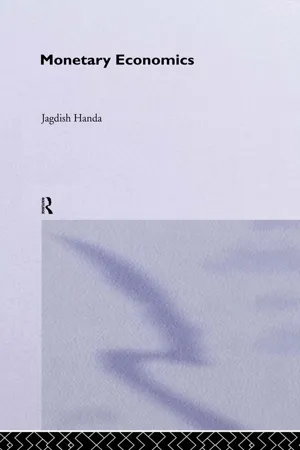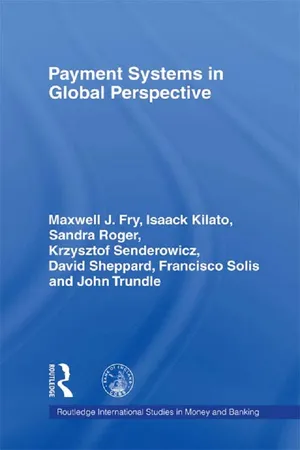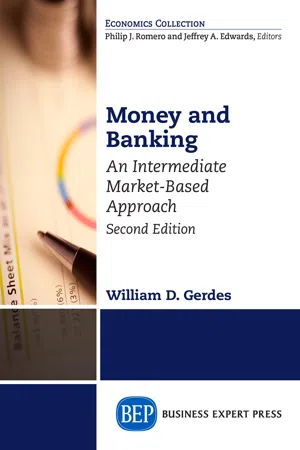Economics
Bank Reserves
Bank reserves refer to the funds that financial institutions are required to hold in reserve to meet potential withdrawals and liabilities. These reserves are typically held in the form of cash or deposits with the central bank. By regulating the level of reserves, central banks can influence the money supply and control inflation.
Written by Perlego with AI-assistance
Related key terms
7 Key excerpts on "Bank Reserves"
- eBook - ePub
- Indranarain Ramlall(Author)
- 2018(Publication Date)
- Emerald Publishing Limited(Publisher)
It is of paramount significance to note that the building up of reserves tends to be a coveted task for countries which are deficient in natural resources as only reserves can act as buffer to cushion these countries from external shocks. Countries which have resources based on natural resource endowments tend to be subject to less stressful conditions in the case of external shocks as they can deplete these resources to accommodate for any pressing external repayments.Since banks often lie at the apex of the financial intermediation roles in many parts of the world, banks’ reserves necessitate a meticulous analysis in the form of liquidity reserves and capital reserves. Unfortunately, neither liquidity reserves nor capital reserves were ample to cushion the detrimental impacts of the global financial crisis on the banks. To cater for such a deficiency, liquidity reserves in the form of net stable funding ratio and liquidity coverage ratio have been recommended by Basel III. Similarly, to remedy for the fact that both liquidity and capital reserves were not effective in dealing with different phases of the business cycles, the countercyclical capital buffer has been introduced by Basel III. Likewise, a capital surcharge has been recommended by Basel III to cope with systemically important financial institutions.3.2. Definition of Reserves
Reserves can be defined as the holding of assets to meet any unforeseen contingencies as and when they fall due. Such a definition signifies that different asset types such as currencies, fixed deposits, real estates, commodities and exchange traded funds can all fall under the purview of reserves. The type of assets held under reserves will vary as per the group of economic units under focus. For instance, reserves held by a household will tend to be more tilted towards real estate assets while those held by central banks will tend to be more tilted towards foreign assets such as internationally accepted currencies and gold. In essence, reserves are held by households, banks, governments, corporates and even central banks. At the economy level, reserves can be endowed or acquired. Endowed reserves constitute reserves which can easily be mined in an economy such as gold mines in South Africa. Acquired reserves represent reserves which are acquired following strenuous economic activities unleashed by a country such as the presence of a robust exporting sector which brings in regular inflows of foreign currencies. Robust holdings of reserves by a specific economic unit enables the latter to best cope with unanticipated shocks likely to generate detrimental impacts, and with these impacts differing as by the type of economic unit under scrutiny. For banks, the shocks manifest in the form of capital erosion, for households, the shocks take the form of subdued probability of being solvent on loans, for corporates, the shock take the form of undermined repayment capacity on loans and, finally, for government, the shocks culminate into heightened public debt levels. - eBook - ePub
- Jagdish Handa(Author)
- 2002(Publication Date)
- Routledge(Publisher)
Households not only hold currency and demand deposits but also hold various forms of time deposits, including savings deposits, term deposits, certificates of deposit (CDs) and their variations. All of these pay interest and we can specify the arguments which would lead to the public’s demand function for time deposits or for its desired ratio of time-to-demand deposits. The derivation of these functions is left to the reader.10.3 COMMERCIAL BANKS: THE DEMAnd for Reserves
Commercial banks hold cash reserves against their deposits. A part of these reserves is normally held in cash (at the tills, in the automatic teller machines or in the bank’s vault) and part is held in demand deposits with the central bank. The sum of these two parts constitutes the banks’ cash reserves.The central bank often requires the commercial banks to meet a certain minimum ratio – called the required reserve ratio 3 – of their reserves to their demand deposit liabilities.4 Chapter 11 will present the required reserve ratios for several countries. In 1999, this ratio was zero in Canada and the United Kingdom. In the United States, it depended on the amount of deposits and varied between 3% and 9% for depository institutions.Banks usually hold reserves in excess of those required to meet the required reserve ratio. Banks also borrow from other banks or the central bank. Reserves held in excess of the sum of required and borrowed reserves are referred to as ‘free reserves ’ – that is, at the bank’s disposal for use if it so desires.The free reserve hypothesis
Free reserves for the banking system as a whole are those in excess of the required reserves and the amount borrowed from the central bank. Free reserves must be distinguished from ‘excess reserves - eBook - ePub
- Maxwell J. Fry(Author)
- 2012(Publication Date)
- Routledge(Publisher)
Central banks that target the level of Bank Reserves usually try to achieve the objective by influencing short-term interest rates. However, it is possible to lose control over short-term interest rates when targeting Bank Reserves. Situations can exist and have existed where large players have attempted and even succeeded in cornering the reserve market. Short-term interest rates may also be influenced by efforts to deliberately incur a shortfall in required reserves. It is clearly in the interests of the central bank to deter such practices in one way or another.5.3Reserves and the Payment System
Before central banks embraced the role of lender of last resort, commercial banks held reserves to meet withdrawals, to make payments and because even a rumour about a reserve shortage could trigger a run on them by depositors. One of the original reasons for establishing central banks was to pool reserves to make banks more secure and at the same time to reduce the amount of reserves banks needed to hold (Bagehot 1873).In the early days of central banking, banks were required to hold reserves both for prudential reasons and for monetary control. Recently reserve requirements have been reduced in France, Japan, Sweden and the United States, and eliminated in Belgium, Canada, Kuwait, Mexico, Norway, Switzerland and the United Kingdom. So now some banks hold reserves only by accident. These banks depend heavily on interbank credit and the money market to settle their payments and to dispose of any excess reserves. However, reserves can be useful to payment systems. In particular, in countries where central bank intraday overdrafts are not granted or overnight overdrafts are severely penalised, banks need to keep some reserves to settle their payments. Three basic approaches to meeting the demand for reserves are discussed in the following sections. A country can also adopt any combination of these approaches.5.3.1Reserve requirements
Required reserve regimes were imposed to control the size of some monetary aggregate rather than for payment purposes. However, most countries using reserve requirements allow these reserves to provide liquidity for the payment system, as shown by the questionnaire results. To free reserves for payment purposes, banks are usually allowed to meet their requirements on an average basis over some maintenance period as, for example, in Poland, Tanzania and the United States. - eBook - ePub
- William D. Gerdes(Author)
- 2017(Publication Date)
- Business Expert Press(Publisher)
Exhibit 4.2 . Bank A has an additional asset in the form of a bank loan. It acquired the asset through the loss of Bank Reserves. Thus, when a bank makes a loan, it can expect to lose reserves in the amount of the loan. It is the availability of Bank Reserves, then, that constrains the volume of lending undertaken by an individual bank.Acquiring Bank Reserves is important to banks. An individual bank can increase its reserves in a number of ways. In competition with other banks, it can lure more customers. When they deposit, they bring reserves. A bank can also liquidate other assets that it holds in order to augment its reserves. Another potential source of Bank Reserves is through issuing liabilities, e.g., by borrowing reserves in the federal funds market.Exhibit 4.2 Net Effects of a Bank LoanEach of these cases is a zero-sum game. When one bank gains reserves, another bank in the system loses reserves. Net additions to Bank Reserves for all banks collectively most often originate through monetary policy. The model of the money supply presented in the next section allows for the investigation of both sources and uses of Bank Reserves. The techniques employed by central banks to increase the total quantity of Bank Reserves are integrated into the model.A Model of the Money SupplyThis money supply model is used to examine factors that determine the total quantity of money. In its basic form, the components are the level of base money (B), the base money multiplier (m), and the quantity of money (M). The model is presented in the form of both levels and differences (absolute changes).M = B (m) (4.2) dM = dB (m) + B (dm) (4.3) Equation (4.2) states that the level of money (money supply) is equal to the level of base money (monetary base or high-powered money) times the level of the base money multiplier. Equation (4.3) expresses the same relationship in terms of differences. The change in the money supply (dM) depends on changes in the monetary base (dB) and changes in the money multiplier (dm). The M1 measure of money is used in this chapter, although it is possible to use the same general model for other measures. - eBook - ePub
Keeping The Central Bank Central
U.S. Monetary Policy And The Banking System
- Weir B Brown(Author)
- 2019(Publication Date)
- Routledge(Publisher)
new reservable categories concerned amounting to about 15 times that reserve level. At the same time, however, the amount of total deposits at member banks had continued to grow, and the overall deposit multiplier in December 1983 and June 1985 reached effective levels about 36-37 times the required reserve figure, as compared with multiples of 16-18 in the preceding decade.These changes in the size of the stock of reserves of the banking system relative to the volume of bank deposits raise important questions for analysis and policy. Some of these relate to the global aggregates just mentioned, total deposits and the total reserve stock. Other questions pertain to the reasons for, and implications of, the narrowed definition of deposits now deemed to call for reserve set-asides. How does the new reserve structure compare with the liability portfolio of the banking system, or with the composition of GNP; and what might this reflect about the Board of Governors' definition of the money supply and policy targeting? We shall attempt a voyage into this territory below, after first examining the limited data available on deposits and reserves of U.S. depository institutions as a group.Publishing of monthly data on member Bank Reserves and deposits was terminated at or before application of the Monetary Control Act, although some of the pertinent figures are published in year-end or semi-annual series. For the expanded group of depository institutions which that Act embraced, data appear monthly on total required reserves, but no corresponding series are published on reservable deposits or total deposits for the group. Figures obtained for this study through the courtesy of the Board staff for June and December 1984 for certain deposit categories and required reserves at a preponderant number of depositories, however, make it possible to present 1984 estimates for the total depository group similar to those examined above for member banks. - eBook - ePub
- Sukumar Nandi(Author)
- 2017(Publication Date)
- Routledge India(Publisher)
Since the late 1950s, many papers have been written on the theme of international reserve, and these come under broadly two categories: The world reserve problem and how the IMF would solve the problem of inadequate world-level liquidity, so that rising trade among the member countries are not adversely affected; the second channel of research continued regarding the optimal level of reserve from the stand point of a single country. The latter problem has assumed importance in view of the floating exchange rate regime established after the collapse of the Bretton Woods Agreement in the early 1970s. There are at least eight reviews of the literature on the subject since 1960 and these are: Clower and Lipsey(1968), Niehans (1970), Salant (1970), Grubel (1970), Williamson (1973), Aizenman and Marion (2003), and Aizenman and Lee (2007).Almost all the studies explain that countries hold international reserve so that they can meet sudden temporary excess demand for foreign exchange and/or to meet short-run adjustment in the balance of trade. The central banks often intervene in the foreign reserve market by selling/buying foreign exchange. International reserves are defined to be assets or credits which can be used directly for intervention, or which can be converted into foreign exchange quickly and with certainty. In practice, it has been necessary to pick up arbitrary cut-off point on such a scale, and define international reserve as assets which are acceptable at all times to foreign economic agents (Machlup, 1966). IMF has to forward estimates of international reserve and these estimates have been widely used in literature for different purposes (Clark, 1971; Flanders, 1971; Kelly, 1970).A country can have international reserve at the macro level and also private liabilities towards foreign exchange. Some authors consider whether international reserve should be adjusted for such private liabilities (Brown, 1964; Kenen and Yudin, 1967). In the monetary theory literature, portfolio theory and financial intermediation have been developed and these tools have been used to explain the movement of international reserve in Kane (1965). Such a framework has some relevance with the discussion in Machlup (1966) and the studies of reserve assets composition (Hageman, 1969; Kenen, 1963). The portfolio model employed in Hageman computed stock-adjustment equation for 11 major countries on quarterly data of the 1950s and early 1960 and the study found good evidence that adjustment was far from instantaneous. - eBook - ePub
- Leonard Jay Santow(Author)
- 2016(Publication Date)
- Routledge(Publisher)
Minimum and maximum limits on reserve requirements were in place before the passage of the Monetary Control Act, The ranges were so wide that the limits were not much of a factor, although for a considerable period after World War II reserve requirements on demand deposits were close to the upper end of the range. Few changes were made in the legal limitations over the years, and when they did occur, the levels generally declined and several categories were added.Minimum and maximum levels for reserve requirements are a questionable proposition. The economic logic of choosing specific levels is hard to understand. Moreover, as deposit instruments, money markets, and bank liability management techniques developed, the use of legal limits became impractical. The limits are now gone and they are missed by no one, which attests to their unimportance.The Current Approach Is Out of Date
The basic philosophy behind reserve requirements is that the quicker a depositor is allowed to withdraw money from a bank, the greater the reserve requirement need. Thus transactions accounts have a reserve requirement while time and Eurocurrency deposits do not. At the end of 1948 the transactions requirement for central reserve city banks (the largest institutions in the system) stood at 26 percent. Almost a half-century later, in a vastly different environment, the ratio is still not insignificant: it is 10 percent. Much of the reasoning for these high requirements stems from concerns about bank failures in the 1930s.Circumstances in the 1950s and much of the 1960s did not create a need for a different reserve requirement approach. Banks were not aggressive in their operations, concentrating instead on meeting demands for fixed-rate, long-term mortgages and fixed-rate, short-term business loans. Banks viewed the deposit side of the balance sheet passively. Few money market instruments existed, and Regulation Q ceilings on interest rates paid on time and savings deposits were in place. When the Fed tightened, banks could not compete for funds once maximum Regulation Q ceilings were breached by money market rates. Banks had few deposit instruments to offer and interest payments were not allowed on demand accounts. Demand funds, along with savings accounts, comprised most of the deposits. Despite these phenomena, the period was not a difficult one for banks. Upward-sloping yield curves, modest liability costs, controllable labor expenses, and only a small amount of bad loans allowed banks to do reasonably well in terms of profit. Banking in many ways was a "sleepytime" operation and competition was a "gentleman's game."
Learn about this page
Index pages curate the most relevant extracts from our library of academic textbooks. They’ve been created using an in-house natural language model (NLM), each adding context and meaning to key research topics.






